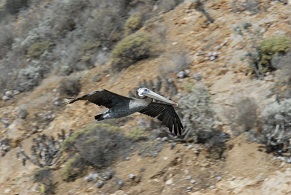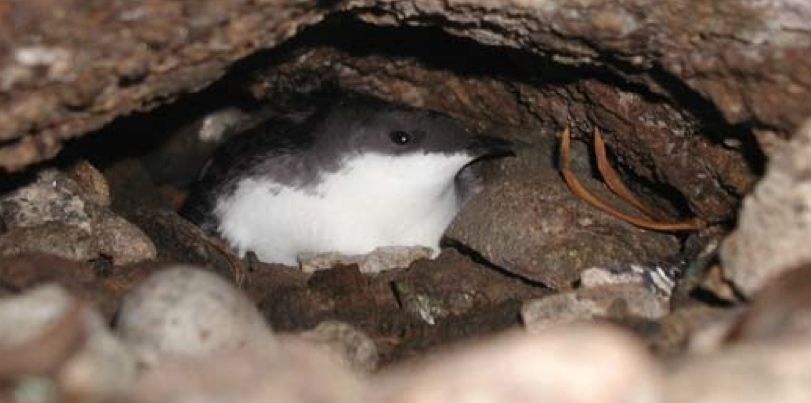Overview
CINMS is located along the Pacific Flyway, a major migratory route for birds. The islands act as a stopover during the birds’ northerly (i.e., April through May) and southerly (i.e., September through December) migrations. In addition, the diversity of habitats on the Channel Islands provides breeding and nesting sites for many resident species, which then forage in sanctuary waters. These island sites are particularly valuable because they are free of mainland predators and immediately adjacent to southern California’s most productive waters. Sandy beaches provide foraging and resting habitat for a number of shorebirds including: black-bellied plover, gulls, long-billed curlew, sanderlings, whimbrel, and willet. The upland portions of the beach provide kelp deposits that attract invertebrates, which are eaten by black and ruddy turnstones (Arenaria melanocephala and A. interpres), dowitchers, and other shorebird species. The islands’ rocky caves and crevices provide nest habitat for Scripps’s murrelets (Synthliboramphus scrippsi) and ashy storm-petrels (Oceanodroma homochroa), while Cassin’s auklets (Ptychoramphus aleuticus) dig burrows in seaside cliffs. Twelve seabird species breed in the Channel Islands, eight of which are granted special protected status under federal or California state law: ashy storm-petrel, black storm-petrel, California brown pelican, California least tern, double-crested cormorant, rhinoceros auklet, Scripps’s murrelet, and western snowy plover.


Photos
Maps
Projects
California Cooperative Oceanic Fisheries Investigations (CalCOFI)
The California Cooperative Oceanic Fisheries Investigations (CalCOFI) was formed in 1949 to study the ecological aspects of the Pacific sardine population collapse off California. Today, the focus has shifted to the study of the marine environment off the coast of California, the management of its living resources, and monitoring the indicators of El Nino and climate change.
California Lost Fishing Gear Recovery Project
The California Lost Fishing Gear Recovery Project was started in July 2005 by the SeaDoc Society (UC Davis Wildlife Health Center). Since its inception, the Project has recovered more than 100 tons of lost fishing gear and other marine debris. The California Lost Fishing Gear Recovery Project proposes to continue to help reduce the potential impact of lost fishing gear on living marine resources and underwater habitat by retrieving lost fishing gear from Channel Islands National Marine Sanctuary (CINMS) and anywhere on the coast where it is a high priority for removal because of demonstrated or potential impacts to marine wildlife and people. 1-888-491-GEAR to report lost, abandoned, and discarded gear.
Channel Islands Naturalist Corps
Channel Islands Naturalist Corps volunteers are trained by CINMS and CINP to educate the public on board local marine excursion vessels conducting whale watch tours, natural history tours, and island trips. Channel Islands Naturalist Corps volunteers are trained to conduct citizen science on marine mammal field identification and general research. Research objectives of the program include the development of a comprehensive database of incidental marine mammal sightings and reports collected in the Santa Barbara Channel, CINMS and CINP.
Tagging of Pacific Predators (TOPP)
The Tagging of Pacific Pelagics (TOPP) research program aims to understand the migration patterns of large predators in the North Pacific basin and how these animals act and interact in their open ocean habitats. By using satellite tagging techniques, TOPP researchers follow the movements of different species across multiple trophic levels (i.e., the food web) and in relation to physical oceanographic features in order to piece together a whole ecosystem picture.Links
A Year on the Wing
Information, activities and resources about birds and the ecology and culture of the places they visit. Includes free shorebird & flyway poster, education kits and much more. Choose documentary in flash or HTML format. Focused on the migratory wading birds of the East Asian-Australasian Flyway.http://www.abc.net.au/wing/ayowflash.htm
Birds of Elkhorn Slough
Resources for birdwatchers at Elkhorn Slough include a checklist, bird sightings log, and more information.http://www.elkhornslough.org/sloughlife/birds/
eBird
eBird, a project developed by the Cornell Lab of Ornithology and the National Audubon Society, provides a simple way for you to keep track of the birds you see anywhere in North America. You can retrieve information on your bird observations at any time for your personal use. You can also access the entire historical database to find out what other eBirders are reporting from across North America. In addition, the cumulative eBird database can be used to learn more about the distributions and movement patterns of birds across the continent.http://www.ebird.org/content/
eBird
eBird, a project developed by the Cornell Lab of Ornithology and the National Audubon Society, provides a simple way for you to keep track of the birds you see anywhere in North America. You can retrieve information on your bird observations at any time for your personal use. You can also access the entire historical database to find out what other eBirders are reporting from across North America. In addition, the cumulative eBird database can be used to learn more about the distributions and movement patterns of birds across the continent.http://www.ebird.org/content/
Elkhorn Slough National Estuarine Research Reserve – Caspian Tern Story
A case study of the trials and tribulations of Caspian Tern nesting colonies at Elkhorn Slough. Also check related information on their general website.http://www.elkhornslough.org/caspiantern/caspiantern.htm
International Brant Monitoring Project
The International Brant Monitoring Project was developed to monitor the migration of a small sea goose, the brant, along the Pacific Flyway. Participants gain a greater understanding of the importance of local ecosystems and global environmental health through the observation of brant and sharing of information. Students monitor through field observations and by counting brant in their area and then share their findings with others via the Internet.http://www.padillabay.gov/brant/
Monterey Bay Aquarium - Online Activity, "Bird Bingo"
The ocean and its coastline are home to hundreds of different types of birds, each with its own size, shape, and color. Bird bingo is a fun way for students to learn more about birds.http://www.mbayaq.org/lc/activities/bird_bingo.asp
Monterey Bay Aquarium - Student and Teacher Resources and Activities
The Monterey Bay Aquarium offers teacher and student resources including: species and habitat-specific information, live cams, classroom activities, and interactive online games.http://www.mbayaq.org/lc/
Monterey Bay National Marine Sanctuary - Seabirds and Shorebirds
A comprehensive and educational scientific characterization of birds in the Monterey Bay Sanctuary.http://montereybay.noaa.gov/sitechar/bird.html
Monterey Bay National Marine Sanctuary - Slideshow
Slideshow that includes photos of landscapes, marine mammals, birds and other organisms found in the Monterey Bay.http://montereybay.noaa.gov/visitor/slideshow/slideshow.html
Monterey Bay Pelagic Bird Images
See photos of pelagic birds taken in the Monterey Bay.http://www.montereybay.com/creagrus/MtyBaybirds.html
OBIS-SEAMAP: Ocean Biological Information System - Spatial Ecological Analysis of Megavertebrate Populations
A digital database of marine mammal, seabird, and sea turtle distribution and abundance. The web-based system will allow the interactive display, query, and analysis of the digital archive in conjunction with environmental data.http://seamap.env.duke.edu/
Pacific Seabird Group - Seabird Gallery
Images of Pacific Seabirds for use in public presentations and education.http://www.pacificseabirdgroup.org
PBRO: Point Reyes Bird Observatory - Conservation Science
PRBO Conservation Science's staff and seasonal scientists apply bird ecology studies to conserve birds, other wildlife and ecosystems in western North America, the north Pacific Ocean and beyond.http://www.prbo.org/cms/index.php
Point Reyes Bird Observatory - Conservation Education
Bird education resources, including: K-12 programs, bird and wildlife information, activities for kids, and information on birding in Pt. Reyes.http://www.prbo.org/cms/index.php?mid=40&module=browse
Satellie Tracking of the Sooty Shearwater
Maps of the Trans-Pacific migration of the Sooty Shearwater from satellite tracking. User must first accept the terms of use for the website.http://www.seaturtle.org/tracking/?project_id=46
Seabird Protection Network
Nearly 8 million people live in the San Francisco Bay Area. This fact, combined with the largest concentration of breeding seabirds in the contiguous U.S., give rise to many opportunities for wildlife disturbance. The Seabird Protection Network uses a 3-pronged approach: 1) Outreach & Education, 2) Enforcement & Coordinated Management, and 3) Monitoring, to informs coastal and ocean users about seabirds. The goal of the Network is to minimize human-related disturbances to breeding and roosting seabird colonies, along the central California coast. Open in new window:http://farallones.noaa.gov/eco/seabird/welcome.html
The Bridge - Ocean Sciences Teacher Resource Center
Materials and curricula related to many areas of study in the Monterey Bay. Be sure to check the data tip of the month archives. (Supported by the National Sea Grant Office, the National Oceanographic Partnership Program, and the National Marine Educators Association.)http://www.vims.edu/bridge/
U.S. Fish and Wildlife Service - Shorebird Sister Schools Program
Linking schools, biologists and shorebird enthusiasts along flyways, students from all over the western hemisphere track arctic-nesting shorebirds along their migration routes and share their class field experiences with other students. Students also have the opportunity to ask biologists questions, follow research projects and help scientists gather data. This site includes many on-line activities and curriculum for students and teachers.http://sssp.fws.gov/index.cfm
USGS - Surf Scoter Study
The San Francisco Bay Estuary Field Station of the U. S. Geological Survey, Western Ecological Research Center has been leading studies on the ecology of wintering waterbird populations and their contaminant risks, including cross-seasonal studies linking them to migration and breeding areas.http://www.werc.usgs.gov/project.aspx?projectid=179